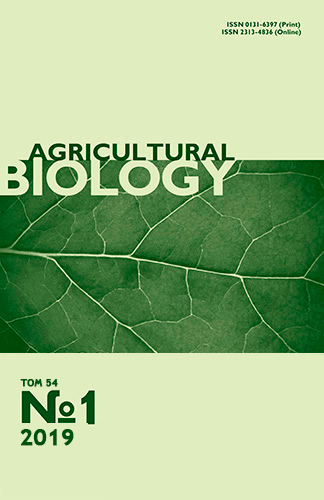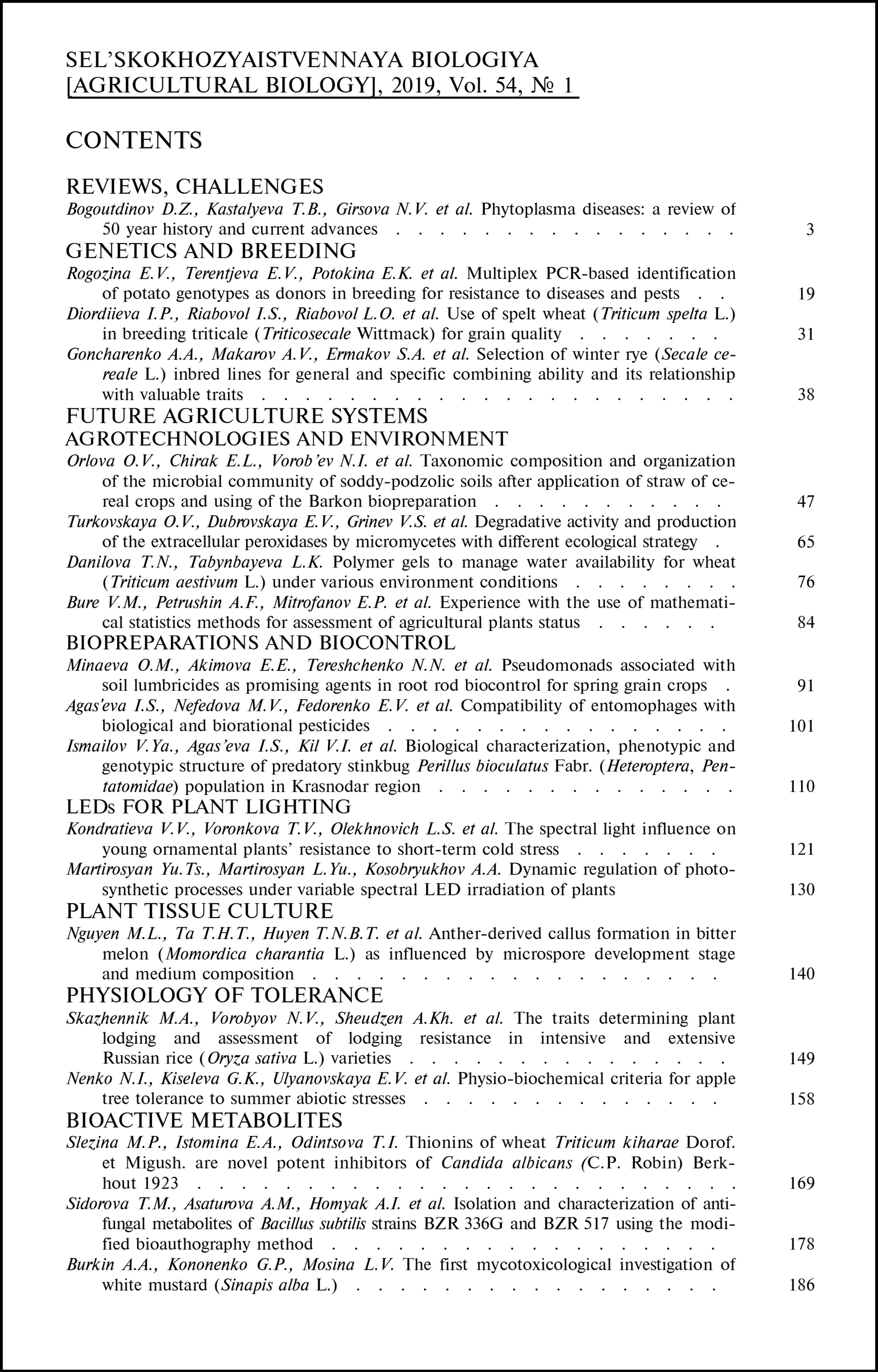doi: 10.15389/agrobiology.2019.1.178eng
UDC 579.64: 632.9
Acknowledgements:
This work was performed according to the state assignment No. 075-00376-19-00 of the Ministry of Science and Higher Education of the Russian Federation within the framework of the research on subject No. 0686-2019-0013.
ISOLATION AND CHARACTERIZATION OF ANTIFUNGAL
METABOLITES OF Bacillus subtilis STRAINS BZR 336G AND BZR 517 USING THE MODIFIED BIOAUTHOGRAPHY METHOD
Т.М. Sidorova, А.М. Asaturova, A.I. Homyak, N.S. Tomashevich
All-Russian Research Institute of Biological Plant Protection, PO box 39, Krasnodar, 350039 Russia, e-mail 0166505@mail.ru (✉ corresponding author), biocontrol-vniibzr@yandex.ru, HomyakAI87@mail.ru, tom-s2@yandex.ru
ORCID:
Sidorova Т.М. orcid.org/0000-0003-4281-5278
Homyak A.I. orcid.org/0000-0001-9360-2323
Asaturova А.М. orcid.org/0000-0002-0060-1995
Tomashevich N.S. orcid.org/0000-0002-7297-5929
Received October 17, 2017
The ability of B. subtilis to produce a large number of biologically active metabolites of diverse structure and properties can largely determine its fungicidal effect against particularly dangerous pathogenic fungi. In this regard, we have studied the fungicidal activity and properties of the antifungal metabolites of active strains B. subtilis BZR 336g and BZR 517. The approach we used, inсluding purification by extraction with ethyl acetate, thin-layer chromatography (TLC), UV fluorescence, tests with detection reagents, spectroscopy and bioautography, showed the potential of the studied B. subtilis strains to accumulate the complex of active metabolites exhibiting antifungal effect from fungistatic to fungicidal. Bioautographic method was modified by use of the causative agents of harmful diseases, F. oxysporum var. orthoceras and Alternaria sp. as test organisms, which allowed us to assess in vitro the antifungal activity. Patterns of the antifungal compounds differed between the strains in TLC mobility and UV fluorescence. The impact on fungal growth also differed, from slight changes in mycelium growth to total suppression. In strain B. subtilis BZR 336g the most pronounced inhibition of F. oksysporum var. orthoceras BZRP1 growth was in bands with Rf 0.39 and 0.96. Significant Alternaria sp. BZRP8 growth inhibition was also observed in two bands, with Rf 0.42 and 0.96. B. subtilis BZR 517 synthesizes metabolites exhibiting fungitoxic properties in four bands with Rf 0.42, 0.84. 0.92 and 0.96 against F. oxysporum var. orthoceras BZRP1, and in two bands with Rf 0.42 and 0.96 against Alternaria sp. BZRP8. It is known that, in addition to the direct action, surfactins and fengicins of B. subtilis prevent the adhesion of competitive microbes on the plant. In out tests, spraying TLC plates with distilled water revealed bands with hydrophobic properties (non-wetting white zones), which can enhance the antagonistic effect of B. subtilis. Test with detection reagents visualized the presence of aromatic amines, phenols, phenolic steroids, methyl hydrazines, that is, compounds that probably play a certain role in the bioactivity manifestation. The weak staining of the metabolites with ninhydrin, as well as the absence of characteristic precipitation during acidification of the culture medium or adding ammonium sulfate, may indicate the presence of only minor amounts of amino acids and peptides. Spectrophotometrically we detected absorption peaks at 205-217 nm wavelengths, which indirectly evidences the presence of polyene structures. Our data allow us to hypothesize mechanisms underlying antifungal effects in the studied B. subtilis strains. These effects may be due to hydrolysis of phenolic compounds, since the detecting reagents indicate various phenolic derivatives, and, according to many researchers’ opinion, active strains, when interacting with a phytopathogen, produce hydrolytic enzymes. As a result, the active groups of phenols can be released, which enhances the antifungal activity of the synthesized metabolites via effect on both fungal cell walls and other cell structures.
Keywords: Bacillus subtilis, microbiological preparations, antifungal metabolites, fungitoxicity, thin-layer chromatography, bioautography, detection reagents, phenolic compounds, polyene structures.
REFERENCES
- Wang T., Liang Y., Wu M., Chen Z., Lin J., Yang L. Natural products from Bacillus subtilis with antimicrobial properties. Chinese J. Chem. Eng., 2015, 23 (I4): 744-754 CrossRef
- Yang H., Li X., Li X., Yu H., Shen Z. Identification of lipopeptide isoforms by MALDI-TOF-MS/MS based on the simultaneous purification of iturin, fengycin and surfactin by RP-HPLC. Anal. Bioanal. Chem., 2015, 407(9): 2529-2542 CrossRef
- Jacobsen B., Zidack N., Larson R. Bacillus isolates and methods of their use to protect against plant pathogens. US Patent № 8246965 A 61 K 39/07 C 12 2012, №1/20.
- Stein T. Bacillus subtilis antibiotics: structures, syntheses and specific functions. Mol. Microbiol., 2005, 56(4): 845-857 CrossRef
- Sidorova Т.М., Asaturova А.М., Homyak A.I. Biologically active metabolites of Bacillus subtilis and their role in the control of phytopathogenic microorganisms (review). Agricultural Biology [Sel’skokhozyaistvennaya Biologiya], 2018, 53(1): 29-37 CrossRef (in Engl.).
- Debois D., Fernandez O., Franzil L., Jourdan E., de Brogniez A., Willems L., Clement C., Dorey S., De Pauw E., Ongena M. Plant polysaccharides initiate underground crosstalk with bacilli by inducing synthesis of the immunogenic lipopeptide surfactin. Env. Microbiol. Rep., 2015, 7(3): 570-582 CrossRef
- Falardeau J., Wise C., Novitsky L., Avis T.J. Ecological and mechanistic insights into the direct and indirect antimicrobial properties of Bacillus subtilis lipopeptides on plant pathogens. J. Chem. Ecol., 2013, 39(7): 869-878 CrossRef
- Alonso S., Martin P.J. Impact of foaming on surfactin production by Bacillus subtilis: implications on the development of integrated in situ foam fractionation removal systems. Biochem. Eng. J., 2016, 110: 125-133 CrossRef
- Shafi J., Tian H., Ji M. Bacillus species as versatile weapons for plant pathogens: a review. Biotechnology & Biotechnological Equipment, 2017, 31(3): 446-459 CrossRef
- Sirec T., Cangiano G., Baccigalupi L., Ricca E., Isticato R. The spore surface of intestinal isolates of Bacillus subtilis. FEMS Microbiology Letters, 2014, 358(2): 1-8 CrossRef
- Novikova I.I., Boikova I.V., Pavlyushin V.A., Zeiruk V.N., Vasil'eva S.V., Azizbekyan R.R., Kuznetsova N.I. Vestnik zashchity rastenii, 2013, 4: 12-21 (in Russ.).
- Tyuterev S.L. Vestnik zashchity rastenii, 2015, 1(83): 3-13 (in Russ.).
- Raaijmakers J.M., de Bruijn L., Nybroe O., Ongena M. Natural functions of lipopeptides from Bacillus and Pseudomonas: more than surfactants and antibiotics. FEMS Microbiol. Rev., 2010, 34: 1037-1062 CrossRef
- Chowdhury S.P., Hartmann A., Geo X.W., Borriss R. Biocontrol mechanism by root-associated Bacillus amyloliquefaciens FZB42 — a review. Front. Microbiol., 2015, 6: Article 780 CrossRef
- Asaturova A.M., Dubyaga V.M. Shtamm bakterii Bacillus subtilis dlya polucheniya biopreparata protiv fitopatogennykh gribov. Patent na izobretenie № 2553518. Opubl. 20.06.2015. Byul. № 17 [The strain of bacteria Bacillus subtilis to obtain a biological product against phytopathogenic fungi. Patent for invention № 2553518. Publ. 06.20.2015. Bul. No. 17] (in Russ.).
- Asaturova A.M., Dubyaga V.M. Shtamm bakterii Bacillus subtilis BZR 517 dlya polucheniya biopreparata protiv fitopatogennykh gribov. Patent na izobretenie № 2552146. Opubl. 10.06.2015. Byul. № 16 [The bacterial strain Bacillus subtilis BZR 517 to obtain a biological product against pathogenic fungi. Patent for invention № 2552146. Publ. 06.10.2015. Bul. No. 16] (in Russ.).
- Asaturova A.M., Dubyaga V.M., Tomashevich N.S., Zharnikova M.D. Elektronnyi politematicheskii nauchnyi zhurnal KubGAU, 2012, 75(01). Available http://ej.kubagro.ru/2012/01/pdf/37.pdf. No date (in Russ.).
- Chigrin V.V., Rozum L.V., Sidorova T.M. Sposob obnaruzheniya fiziologicheski aktivnykh veshchestv rastitel'nogo proiskhozhdeniya. A. s. SU 1824146A1 A 01 N 61/00 G 01 N 30/90 № 1824146. Zayavl. 11.01.91. Opubl. 30.06.93 g. Byul. № 24 [The method of detection of physiologically active substances of plant origin. A.C. SU 1824146A1 A 01 N 61/00 G 01 N 30/90 No. 1824146. Appl. 01.11.91. Publ. 30.06.93. Bull. No. 24](in Russ.).
- Kirkhner Yu. Tonkosloinaya khromatografiya. T. 1 [Thin layer chromatography. V. 1]. Moscow, 1981: 221-285 (in Russ.).
- Zhang B., Dong C., Shang Q., Han Y., Li P. New insighs into membrane-active action in plasma membrane of fungal hyphae by the lipopeptide antibiotic bacillomycin L. BBA-Biomembranes, 2013, 1828(9): 2230-2237 CrossRef
- Wise C., Falardeau J., Hagberg I., Avis T. Cellular lipid composition affects sensitivity of plant pathogens to fengycin, an antifungal compound produced by Bacillus subtilis strain CU12. Phytopathology, 2014, 104(10): 1036-1041 CrossRef
- Santos A., Mendes S., Brissos V., Martins L.O. New dye-decolorizing peroxidases from Bacillus subtilis and Pseudomonas putida MET94: towards biotechnological applications. Appl. Microbiol. Biotechnol., 2014, 98: 2053 CrossRef
- Guo Q., Dong W., Li S., Li X., Wang P., Zhang X., Wang Y., Ma P. Fengycin produced by Bacillus subtilis NCD-2 plays a major role in biocontrol of cotton seedling damping-off disease. Microbiol. Res., 2014, 169(7-8): 533-540 CrossRef
- Romero D. The iturin and fengycin families of lipopeptides are key factors in antagonism of Bacillus subtilis toward Podosphaera fusca. MPMI, 2007, 20(4): 430-440 CrossRef
- Ongena M., Jacques P., Toure Y., Destan J., Jabrane A., Thonart P. Involvement of fengycin-type lipopeptides in the multifaceted biocontrol potential of Bacillus subtilis. App. Microbiol. Biotechnol., 2005, 69(1): 29-38 CrossRef
- Falardeau J., Wise C., Novitsky L., Avis T.J. Ecological and mechanistic insights into the direct and indirect antimicrobial properties of Bacillus subtilis lipopeptides on plant pathogens. J. Chem. Ecol., 2013, 39(7): 869-878 CrossRef
- Kudryashova E.B., Vinokurova N.G., Arishina E.V. Bacillus subtilis and phenotypically similar strains producing hexaene antibiotics. Applied Biochemistry and Microbiology, 2005, 41: 553-557 CrossRef
- Malanicheva I.A., Kozlov D.G., Efimenko T.A., Zenkova V.A., Katrukha G.S., Reznikova M.I., Korolev A.M., Borshchevskaya L.N., Tarasova O.D., Sineokii S.P., Efremenkova O.V. Mikrobiologiya, 2014, 83(4): 445-450 (in Russ.).
- Kim P.I., Ryu J., Kim Y.H., Chi Y.-T. Production of biosurfactant lipopeptides iturin A, fengycin and surfactin A from Bacillus subtilis CMB32 for control of Colletotrichum gloeosporioides. J. Microbiol. Biotechnol., 2010, 20(1): 138-145 CrossRef
- Pirog T.P., Konon A.D., Savenko I.V. Microbial surfactants in environmental technologies. Biotechnologia Acta, 2015, 8(4): 21-39 CrossRef












